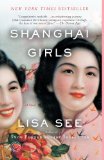Summary | Excerpt | Reading Guide | Reviews | Beyond the Book | Read-Alikes | Genres & Themes | Author Bio

A Novel
by Lisa SeeThis article relates to Shanghai Girls
In Shanghai Girls, Pearl and May are incarcerated at the Angel Island Immigration Station after fleeing war-torn China. Angel Island was the first stop for most Chinese entering the United States during this period; 175,000 were processed there during its thirty years of operation.
Chinese immigration to the United States began in the mid-1800s as a result of
the California Gold Rush. Although initially welcomed, or at least tolerated, an economic downturn in the 1870s created resentment as the immigrants willingness to work for low wages was viewed as depriving others of gainful employment. This led to a series of immigration laws targeting Asians, beginning with the Chinese Exclusion Act of 1882, which banned all Chinese from entering the United States with the exception of merchants, clergy, diplomats, teachers, students, and wives and children of US citizens.
The 1906 earthquake and fire in San Francisco created a loophole in the immigration act. Most municipal records burned, allowing thousands of Chinese men already in the United States to claim they were born there, and were therefore citizens. Some of these men would later leave to visit China, and on their return bring wives and children with them claiming that they had married or had children while overseas. This was possible because children born to US citizens are automatically citizens, and women did not become citizens in their own right until the 1920s, up until then they were were awarded the same citizenship as their father until they were married, and then their husband. Creating "paper sons" was a very lucrative business. Not only could a man charge as much as $1400 (~$30,000 today), but the new immigrant became slave labor to his "father" to pay off his boat fare, lodging and food.
The US government sought to minimize the number of illegal immigrants entering
the country this way by opening a detention station where prospective citizens could be housed and interrogated - thus, in 1910, the Angel Island Immigration Station in the San Francisco Bay was opened. On arriving in San Francisco, Europeans were processed quickly and released but the Chinese, and immigrants from other Pacific Rim nations, were ferried to Angel Island where the men and women were separated and they were all submitted to an invasive medical exam. Those who failed the physical were deported immediately, while those remaining were incarcerated in barracks to await interrogation.
The barracks were hastily built wooden dormitories consisting of rows of three-tiered bunk beds. The women's facilities held 70 – 100 in a single room, with more in the men's barracks. They were crowded, unsanitary, and lacked privacy. The immigrants were confined to the barracks, allowed outside only for meals, interrogations, or brief, supervised exercise periods.
The interviews were grueling. A person would be questioned for hours on end,
sometimes over several days, about the minutiae of their lives. These answers would then be compared to that provided by family members. If all details
matched, the person would eventually be released; otherwise, they'd be subject
to either more grilling or deported outright. The average stay on Angel Island
was two to three weeks, but it often stretched to months.
A fire leveled the administration building in 1940, and the facility was
closed as a result. The California Department of Parks and Recreation established Angel Island as a state park in 1963, and in 1997 it became a National Historic Landmark.
For more about the back-story to Shanghai Girls, see Lisa's extensive Q&A.
Filed under Places, Cultures & Identities
![]() This "beyond the book article" relates to Shanghai Girls. It originally ran in June 2009 and has been updated for the
February 2010 paperback edition.
Go to magazine.
This "beyond the book article" relates to Shanghai Girls. It originally ran in June 2009 and has been updated for the
February 2010 paperback edition.
Go to magazine.




When a true genius appears in the world, you may know him by this sign...
Click Here to find out who said this, as well as discovering other famous literary quotes!
Your guide toexceptional books
BookBrowse seeks out and recommends the best in contemporary fiction and nonfiction—books that not only engage and entertain but also deepen our understanding of ourselves and the world around us.